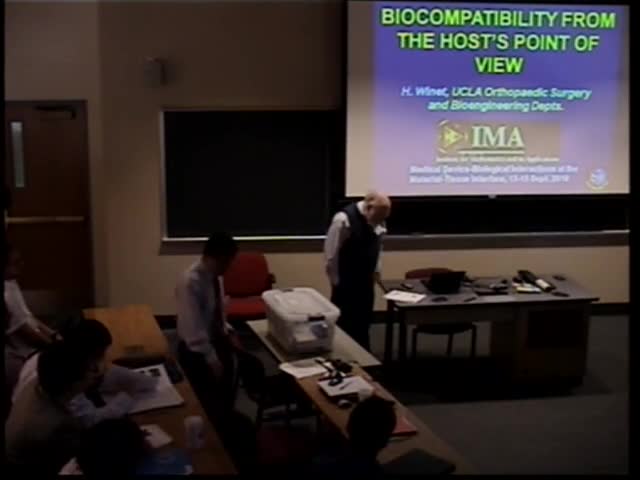Biocompatibility from the host's point of view
Presenter
September 13, 2010
Keywords:
- Medical
MSC:
- 92C50
Abstract
An implant enters a host during trauma, the wounding
process of surgery. Trauma initiates a healing course that
naturally progresses through inflammatory and repair phases
before host tissue settles down to scar or in some tissues
progresses to regeneration. The presence of an implant alters
healing if only by occupying space once filled with host
tissue. In the most desirable scenario host tissue returns to
normal function at a level above the condition that initiated
implantation, and soon enough to ensure the overall health of
the patient. The ability of an implant to achieve this goal is
a measure of its biocompatibility as defined by Jonathan Black.
There is ample evidence to warn any implant developer
that host tissue is aware of the foreign object it surrounds,
from nanoparticles to lung transplants. Response to the
construct may range from coating it with a thin layer of
fibroblasts to development of life-threatening anaphylactic
shock. A successful biomaterials developer understands host
wound healing physiology in the presence of an implant well
enough to anticipate and reduce undesirable host responses.
Where surgical trauma was preceded by an injury that opened
skin, there is the complication of infection to anticipate.
Host reaction begins with a molecular race to initiate
a biofilm on the implant surface. The critical molecules are
proteins like albumin and complement. Within seconds platelets
and then cells adhere to the molecular film. These cells are
also in the race for the surface. Those that remain adhered
to the film are often determined by the molecular composition
of the film. If some of these cells are bacteria the future of
the implant is in danger.
The most influential adherent cell at this stage is the
macrophage. Macrophages direct the healing process and decide
if implant material is a threat. If the biomaterial is deemed
a threat a foreign body reaction will be initiated. This
response is part of what is called the innate immune response
that is initiated by attached complement. The function of an
FBR is to destroy the threat. Failing this, macrophages will
direct walling it off from healthy host tissue with scar
tissue.
Innate immunity gets its name from the fact that it is
programmed and prepared to operate before triggered by any
implant. Natural selection in the form of rapid bacterial
evolution has pushed higher animals to develop responses to
materials not covered by innate immunity. These come from the
adaptive immune system and involve lymphocytes.
The interaction of macrophages, lymphocytes and a close
relative of macrophages, dendritic cells creates a rather
complex scheme of host reaction to implants that challenge the
design of biomaterials meant reside for long terms in human
hosts. Recent discovery of previously unknown ways by which
these cells communicate with each other (e.g. Toll-like
receptors) intensify the challenge.
As the implant ages and appears to have achieved
compatibility, a new challenge may emerge. Wear. Corrosive
body fluids and abrasion may create effectively new materials.
Wear particles and metal ions not released by the original
implant may challenge the host. Bacteria that succeeded in
forming a biofilm at implantation may grow colonies large
enough to break the film membrane and spread infection into
surrounding tissue. Consideration of these possibilities may
induce an implant designer to consider inclusion of removal
facilitation in the original design. Recently a number of
laboratories have designed anti-bacterial films to block
establishment of biofilms.
These challenges will be described in more detail.
